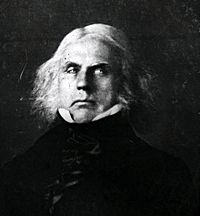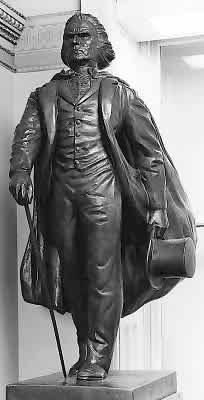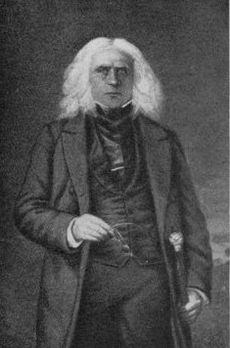John McLoughlin facts for kids
Quick facts for kids
John McLoughlin
|
|
|---|---|

Digital photograph made from a lantern slide of Dr. John McLaughlin
|
|
| Born |
Jean-Baptiste McLoughlin
October 19, 1784 |
| Died | September 3, 1857 (aged 72) |
| Employer | Hudson's Bay Company and North West Company |
| Known for | Fort Vancouver and Fort William, Ontario |
| Title | Chief Factor |
| Successor | James Douglas |
| Spouse(s) | Marguerite McLoughlin, (married Nov 1842) |
John McLoughlin, also known as Jean-Baptiste McLoughlin, was an important leader in the fur trade. He was born on October 19, 1784, and passed away on September 3, 1857. He worked as a top manager, called a Chief Factor, for the Hudson's Bay Company at Fort Vancouver. This fort was a key trading post in the Columbia District from 1824 to 1845.
Later, he became known as the "Father of Oregon." This was because he helped American settlers in the Oregon Country. In the late 1840s, his store in Oregon City was a famous stop for people traveling the Oregon Trail.
Contents
John McLoughlin: Early Life and Career
Growing Up in Quebec
John McLoughlin was born in October 1784 in Rivière-du-Loup, Quebec. His family had both Scottish and French-Canadian roots. As a child, he lived for a time with his great-uncle, Colonel William Fraser.
Even though he was baptized a Roman Catholic, he grew up following the Anglican faith. Later in his life, he returned to the Roman Catholic Church.
Becoming a Doctor
In 1798, John began studying medicine. He learned from Sir James Fisher in Quebec. By 1803, McLoughlin received his license to practice medicine in Lower Canada (which is now Quebec). Because of his training, he was often called "Dr. John McLoughlin."
Joining the North West Company
McLoughlin started working as a doctor at Fort William. This was a major fur trade post for the North West Company on Lake Superior. While there, he also became a fur trader. He learned several Indigenous languages, which helped him in his work. By 1814, he became a partner in the company.
The North West Company later merged with the Hudson's Bay Company in 1821. McLoughlin played a big part in these important discussions. After the merger, he was temporarily put in charge of the Lac la Pluie district.
Leading the Hudson's Bay Company

In 1824, the Hudson's Bay Company chose McLoughlin to be the Superintendent of the Columbia Department. This area was similar to what Americans called the Oregon Country. At this time, both the United States and Britain shared control of the region. This was part of the Treaty of 1818.
When McLoughlin arrived, he decided that the company's main base, Fort Astoria (now Astoria), was not in a good location. He needed to find a better spot for their operations.
Building Fort Vancouver
McLoughlin decided to build a new main fort called Fort Vancouver. It was located on the north side of the Columbia River. This spot was chosen by Sir George Simpson, the Governor of the Hudson's Bay Company. The new fort opened for business on March 19, 1825.
From Fort Vancouver, McLoughlin managed trade and kept peace with local Indigenous groups. He also started trading salmon and timber with California and Hawaii. He even supplied Russian America with goods.
Fort Vancouver became the busiest place in the Pacific Northwest. Ships from London would arrive each year with supplies and trade items. They would then take furs back to Europe. The fort was the center of the fur trade for a huge area. Its influence reached from the Rocky Mountains to the Hawaiian Islands, and from Russian Alaska down to Mexican-controlled California.
At its busiest, McLoughlin oversaw 34 smaller trading posts, 24 ports, six ships, and 600 employees from Fort Vancouver. Under his leadership, the Columbia Department made a lot of money. This was partly because there was a high demand for beaver hats in Europe.
The York Factory Express
By 1825, two main groups, called brigades, would travel across the continent. One brigade started from Fort Vancouver and the other from York Factory on Hudson Bay. They would usually meet in the middle of their journey. Each brigade had about 40 to 75 men and special boats. They traveled very quickly for that time.
These brigades often got help from Indigenous people. They would help the men carry their boats and goods around waterfalls and difficult rapids. In return, the Indigenous people received trade goods. A report from 1839 said the trip took about three months and ten days. This meant they traveled almost 26 miles (40 km) each day on average. They used boats, horses, and even carried backpacks to move supplies to the forts and bring furs back out.
Puget Sound Agricultural Company
The Hudson's Bay Company generally did not want settlers in the area. They felt that farming and settlements would get in the way of the profitable fur trade. However, things started to change in the late 1830s. There were growing concerns about American interest in the region.
To help support British claims and meet new trade needs, the Hudson's Bay Company created a new company in 1840. It was called the Puget Sound Agricultural Company (PSAC). This company focused on farming. McLoughlin was put in charge of the PSAC, even though he thought independent farmers would be more efficient.
The main PSAC farm was called Cowlitz Farm. It was located on fertile land near the Cowlitz River. Fort Nisqually also became part of the PSAC, where many animals were raised. Farmers were brought in from places like the Red River colony and Scotland.
In 1841, a group of 23 families, totaling 121 people, traveled from Fort Garry to Fort Vancouver to work for the PSAC. Most of these families were Metis. When they arrived, 14 families moved to Fort Nisqually, and the other seven went to Fort Cowlitz.
Japanese Shipwreck
When three Japanese sailors, including Otokichi, were shipwrecked on the Olympic Peninsula in 1834, McLoughlin saw a chance. He thought this might open up trade with Japan. He sent the three men to London to try and convince the British government of his idea. They reached London in 1835.
However, the British Government was not interested in trading with Japan. So, the sailors were sent to Macau. The goal was to return them to Japan, but Japan at that time did not allow any outside ships into its waters.
Relations with American Settlers
As the leader at Fort Vancouver, McLoughlin worked to keep peace with Indigenous groups. He also tried to maintain order among British and American settlers.
In August 1828, American explorer Jedediah Smith arrived at Fort Vancouver. He was one of only a few survivors from his group after a difficult journey. McLoughlin sent a team to help recover Smith's belongings.
In the early 1840s, many American settlers began arriving on the Oregon Trail. McLoughlin went against his company's wishes and gave a lot of help to these American newcomers. He provided them with food and supplies. This help likely prevented conflicts between the settlers and his trading post. Some settlers did not fully trust his reasons for helping, but his actions were very important.
Debates Over the Pacific Northwest
As tensions grew over who would control the Oregon Country, McLoughlin was asked to move the main headquarters to Vancouver Island. He directed James Douglas to build Fort Camosun (now Victoria, Canada) in 1843. However, McLoughlin himself chose to stay in the Willamette River Valley, where his life was becoming more settled.
McLoughlin was involved in discussions about the future of the Oregon Country. He supported the idea of an independent nation, separate from the United States. This idea gained some support at first.
In 1843, American settlers created their own government, called the Provisional Government of Oregon. They wrote laws that included creating a leadership committee, a court system, and rules for land. This government continued to operate until 1849, even after the Oregon Treaty of 1846 set the border at the 49th parallel, making the land south of it part of the United States.
Later Life in Oregon
After leaving the Hudson's Bay Company in 1846, McLoughlin moved his family to Oregon City. This area was now part of the Oregon Territory of the United States. Many settlers were arriving here via the Oregon Trail. At his store in Oregon City, he sold food and farming tools to these new settlers.
In 1847, McLoughlin received a special honor called the Knighthood of St. Gregory from Pope Gregory XVI. He became a U.S. citizen in 1849. McLoughlin faced personal sadness, including the loss of his son.
He served as mayor of Oregon City in 1851. He won the election with 44 out of 66 votes. John McLoughlin passed away in 1857 from natural causes. His grave is located next to his home, which overlooks downtown Oregon City.
Legacy and Recognition
John McLoughlin is remembered as a very important figure in the history of Oregon.
In 1953, the state of Oregon gave a bronze statue of McLoughlin to the National Statuary Hall Collection. This statue is now on display at the Capitol Visitor Center in Washington D.C. In 1957, on the 100th anniversary of his death, the Oregon Legislative Assembly officially gave him the title "Father of Oregon."
Many places in Oregon are named after him, including:
- Mount McLoughlin
- The John McLoughlin Bridge
- McLoughlin Boulevard, a major street between Oregon City and Portland
- Many schools
McLoughlin's former home in Oregon City is now a museum. It is known as the McLoughlin House and is part of the Fort Vancouver National Historic Site.


